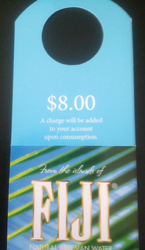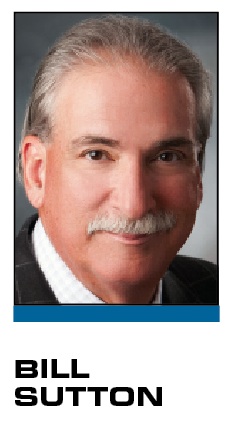I was unpacking in my hotel room in Phoenix a few weeks ago and noticed a bottle of Fiji water on the desk. There was a hangtag on the bottle. I picked it up — and experienced sticker shock. The price was $8, and I knew I had a topic for my next column.
We all know there is an up-charge for certain products or services based on specific criteria. Location and opponent/star power, day of the week, time of the year, and demand itself are the most prominent pricing considerations in the sports industry. In fact, these are some of the key criteria that are used in variable and dynamic pricing models. There are other criteria, such as convenience, which also figure into the pricing formulas. Unfortunately, convenience is something that is being leveraged heavily, and without regard for the consumer and the potential lifetime value of that customer.
 |
Let’s go back to the water for the moment. If I were to drive about a mile from the hotel where I was staying, I could purchase that same bottle of water for about $2.50. The provider, in this case the hotel, understands that I have the ability to do that, but it also understands that the likelihood of me doing that isn’t very high. It might also consider that I am a business traveler, and there is a good chance I will merely pass that cost on to my client. (Personally, I would not want to answer to my client about why I needed an $8 bottle of water). It could also consider that perhaps this is my only trip to the market and thus it wishes to maximize the opportunity to profit on my visit. While this is shortsighted, it does occur much more frequently that we would like to believe.
Example No. 2: Gasoline prices. Gas prices are significantly higher at
 |
Pricing for convenience can create a backlash if the consumer feels exploited.
Photos by: BILL SUTTON (2)
|
the service station closest to the rental car return at the Orlando International Airport than at any other service station a mile away. While the prices are much higher, it is less expensive than having the rental car company fill the tank, which might be $2 to $3 per gallon higher than this exorbitant price.
Speaking of rental cars, I just returned from a trip to Portland to attend the NCAA tournament games. Cost for a pick-up on Wednesday afternoon and a return on Sunday morning: $538 from a discount provider, because Portland, like many other cities, has elected to tack on fees and taxes (in my case, almost $200) for the out-of-town “guests” who may or may not return.
What these providers are failing to realize is the emotional alienation they are creating for the consumer who resents that he or she has been taken advantage of and resolves not only to not patronize that provider again, but also to blog, tweet, share pictures and tell stories to warn other potential customers about this exploitative business practice.
Sports providers and their vendors are no less exploitative, often creating and forcing purchases in what can only be viewed as an almost hostage-type situation because there is limited choice or, in some cases, no alternative — given that you cannot leave and re-enter the venue to make a purchase elsewhere.
Some examples for you to ponder:
■ Service charges per ticket rather than per order. Do teams really expect consumers to believe that for an order of six tickets the convenience and service charges are six times the cost of purchasing one ticket?
■ That it is acceptable to not allow consumers to enter a venue with a bottle of water, and then use the PA system to make announcements regarding the danger of dehydration and urging everyone to stay properly hydrated while selling water for $4 per bottle.
■ Only selling soft drinks in cups that are 16 ounces or larger, forcing customers to buy much more than they need at a higher price.
■ Selling a beer for $9. Really? Is it that much more to pour beer at a stadium than it is at a tavern?
This takes a toll on the “emotional bank account” that fans associate with their teams and preferred entertainment outlets. An emotional bank account receives deposits for great fan experiences, team performance, player/fan interaction and gestures that demonstrate the consumer is appreciated. A withdrawal occurs when the consumer is upset with team performance, feels there is no direction for the team, and feels taken advantage of and dictated to. When the account balance hits zero, the consumer finds a new option to invest in.
So the argument is, Why do we behave this way when, in the world of choices and alternatives in which we live, the consumer has countless other options to seek out entertainment and value? The easiest way to explain the growth of the secondary ticket market and the value ticket market is that the primary providers were not offering the products at the price the consumers wanted to pay or were forcing the consumers to buy more than they wanted to buy. These suppliers have learned to embrace customization because they have learned that consumers will pay more for customization that fits their needs.
Homework assignment for teams: Try to disprove my point of view. Review all of your variable or variable-dynamic hybrid prices for the top two tiers of your games (A and B games). How is the secondary ticket market pricing these games? What percentage of your season-ticket holders are selling/attempting to sell these games, and how successful are they?
I think you will find that while you charged what you could, it probably is better to find a price where you should. That is why I am a proponent of true dynamic pricing. A steady, long-term profit results in higher retention of your customers than an exploitative, short-term grab.
Bill Sutton (wsutton@bus.ucf.edu), effective May 6, will be the founding director of the Sport and Entertainment Management MBA/MS Program at the University of South Florida in Tampa, and principal of Bill Sutton & Associates. Follow him on Twitter @Sutton_Impact.






